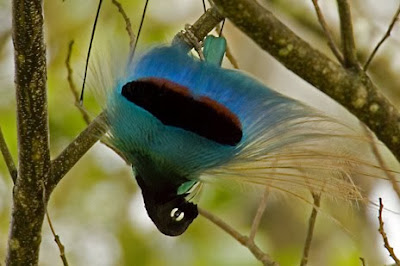 |
| Paradisaea Rudolphi |
Birds of Paradise is one of the most spectacular
and colorful groups of birds in the world, blue bird of paradise (Paradisaea
Rudolphi) with stunning plumage is no exception. Blue bird of paradise has blue
quills on the wings, back and tail, the beak color is ivory, has a white circle
around the eyes. Birds of Paradise as males handles delightful blue tail quills
of two delicate, long ribbons, but in contrast to the dark male, females have
brown underside.
During the operation of mating, males produce rhythmic
"wahr wahr" connection. |
| Paradisaea Rudolphi Hanging downside |
Behaviour:
Birds
of Paradise display stunning plumage used to attract mates . Males compete in
what is known as lekking system , where each bird has its own small screen,
with which they can impress the females that pass through . In their
presentation, they reveal full extension of its magnificent plumage hanging
upside down on trees and is spreading its wings, giving a combination of tone.
 |
| Paradisaea Rudolphi |
Habitat & Threat:
The Blue bird of paradise is endemic to Papua New Guinea,
blue bird of paradise is located east of the central mountains. Blue bird of
paradise inhabits tropical and subtropical moist forests, usually between 1,400
and 1,800 meters above sea level. Blue Bird of Paradise is located mostly in the forest canopy
, where the major part of their diet consists of fruit . Loss of habitat for the survival of blue bird of paradiseis
the main threat . Most of the native forests of Papua New Guinea is now cleared
to make way for agriculture and development, and it is likely that the small
population of blue bird of paradise is becoming increasingly excerpted.
Colorful plumes of these birds traditionally been demand and remains to be
targeted by trappers .
No comments:
Post a Comment